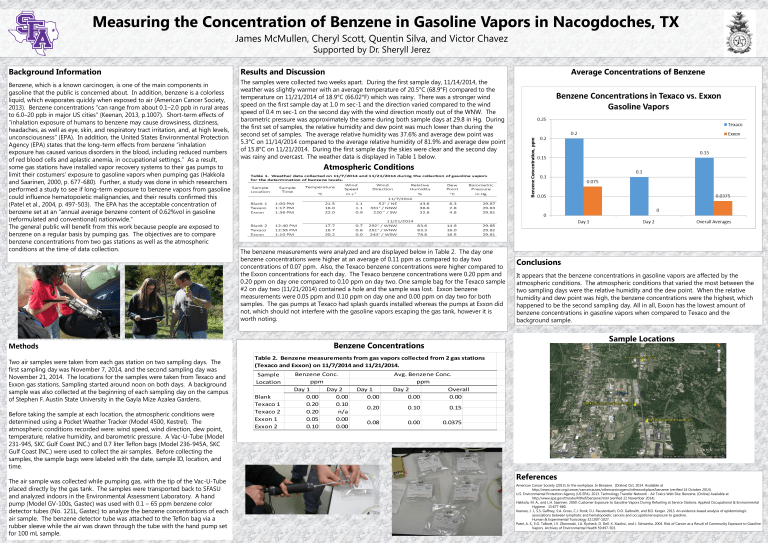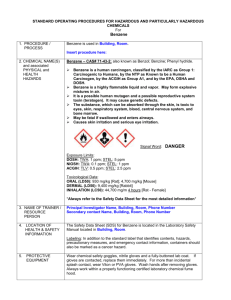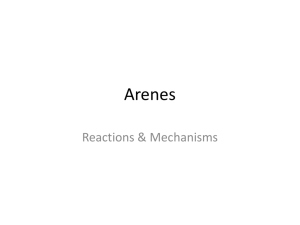Measuring the Concentration of Benzene in Gasoline Vapors in Nacogdoches,... James McMullen, Cheryl Scott, Quentin Silva, and Victor Chavez

Measuring the Concentration of Benzene in Gasoline Vapors in Nacogdoches, TX
James McMullen, Cheryl Scott, Quentin Silva, and Victor Chavez
Supported by Dr. Sheryll Jerez
Results and Discussion Average Concentrations of Benzene Background Information
Benzene, which is a known carcinogen, is one of the main components in gasoline that the public is concerned about. In addition, benzene is a colorless liquid, which evaporates quickly when exposed to air (American Cancer Society,
2013). Benzene concentrations “can range from about 0.1–2.0 ppb in rural areas to 6.0–20 ppb in major US cities” (Keenan, 2013, p.1007). Short-term effects of
“inhalation exposure of humans to benzene may cause drowsiness, dizziness, headaches, as well as eye, skin, and respiratory tract irritation, and, at high levels, unconsciousness” (EPA). In addition, the United States Environmental Protection
Agency (EPA) states that the long-term effects from benzene “inhalation exposure has caused various disorders in the blood, including reduced numbers of red blood cells and aplastic anemia, in occupational settings.” As a result, some gas stations have installed vapor recovery systems to their gas pumps to limit their costumers’ exposure to gasoline vapors when pumping gas (Hakkola and Saarinen, 2000, p. 677-680). Further, a study was done in which researchers performed a study to see if long-term exposure to benzene vapors from gasoline could influence hematopoietic malignancies, and their results confirmed this
(Patel et al., 2004, p. 497-503). The EPA has the acceptable concentration of benzene set at an “annual average benzene content of 0.62%vol in gasoline
(reformulated and conventional) nationwide.”
The general public will benefit from this work because people are exposed to benzene on a regular basis by pumping gas. The objectives are to compare benzene concentrations from two gas stations as well as the atmospheric conditions at the time of data collection.
The samples were collected two weeks apart. During the first sample day, 11/14/2014, the weather was slightly warmer with an average temperature of 20.5°C (68.9°F) compared to the temperature on 11/21/2014 of 18.9°C (66.02°F) which was rainy. There was a stronger wind speed on the first sample day at 1.0 m sec-1 and the direction varied compared to the wind speed of 0.4 m sec-1 on the second day with the wind direction mostly out of the WNW. The barometric pressure was approximately the same during both sample days at 29.8 in Hg. During the first set of samples, the relative humidity and dew point was much lower than during the second set of samples. The average relative humidity was 37.6% and average dew point was
5.3°C on 11/14/2014 compared to the average relative humidity of 81.9% and average dew point of 15.8°C on 11/21/2014. During the first sample day the skies were clear and the second day was rainy and overcast. The weather data is displayed in Table 1 below.
Atmospheric Conditions
The benzene measurements were analyzed and are displayed below in Table 2. The day one benzene concentrations were higher at an average of 0.11 ppm as compared to day two concentrations of 0.07 ppm. Also, the Texaco benzene concentrations were higher compared to the Exxon concentrations for each day. The Texaco benzene concentrations were 0.20 ppm and
0.20 ppm on day one compared to 0.10 ppm on day two. One sample bag for the Texaco sample
#2 on day two (11/21/2014) contained a hole and the sample was lost. Exxon benzene measurements were 0.05 ppm and 0.10 ppm on day one and 0.00 ppm on day two for both samples. The gas pumps at Texaco had splash guards installed whereas the pumps at Exxon did not, which should not interfere with the gasoline vapors escaping the gas tank, however it is worth noting.
Conclusions
It appears that the benzene concentrations in gasoline vapors are affected by the atmospheric conditions. The atmospheric conditions that varied the most between the two sampling days were the relative humidity and the dew point. When the relative humidity and dew point was high, the benzene concentrations were the highest, which happened to be the second sampling day. All in all, Exxon has the lowest amount of benzene concentrations in gasoline vapors when compared to Texaco and the background sample.
Sample Locations
Methods
Two air samples were taken from each gas station on two sampling days. The first sampling day was November 7, 2014, and the second sampling day was
November 21, 2014. The locations for the samples were taken from Texaco and
Exxon gas stations. Sampling started around noon on both days. A background sample was also collected at the beginning of each sampling day on the campus of Stephen F. Austin State University in the Gayla Mize Azalea Gardens.
Before taking the sample at each location, the atmospheric conditions were determined using a Pocket Weather Tracker (Model 4500, Kestrel). The atmospheric conditions recorded were: wind speed, wind direction, dew point, temperature, relative humidity, and barometric pressure. A Vac-U-Tube (Model
231-945, SKC Gulf Coast INC.) and 0.7 liter Teflon bags (Model 236-945A, SKC
Gulf Coast INC.) were used to collect the air samples. Before collecting the samples, the sample bags were labeled with the date, sample ID, location, and time.
The air sample was collected while pumping gas, with the tip of the Vac-U-Tube placed directly by the gas tank. The samples were transported back to SFASU and analyzed indoors in the Environmental Assessment Laboratory. A hand pump (Model GV-100s, Gastec) was used with 0.1 – 65 ppm benzene color detector tubes (No. 121L, Gastec) to analyze the benzene concentrations of each air sample. The benzene detector tube was attached to the Teflon bag via a rubber sleeve while the air was drawn through the tube with the hand pump set for 100 mL sample.
Benzene Concentrations
Table 2. Benzene measurements from gas vapors collected from 2 gas stations
(Texaco and Exxon) on 11/7/2014 and 11/21/2014.
Sample
Location
Blank
Texaco 1
Texaco 2
Exxon 1
Exxon 2
Benzene Conc.
ppm
Day 1
0.00
0.20
0.20
0.05
0.10
Day 2
0.00
0.10
n/a
0.00
0.00
Day 1
0.00
0.20
0.08
Avg. Benzene Conc.
ppm
Day 2
0.00
Overall
0.00
0.10
0.00
0.15
0.0375
References
American Cancer Society (2013). In the workplace. In Benzene. [Online] Oct. 2014. Available at http://www.cancer.org/cancer/cancercauses/othercarcinogens/intheworkplace/benzene (verified 14 October 2014).
U.S. Environmental Protection Agency (US EPA). 2013. Technology Transfer Network - Air Toxics Web Site: Benzene. [Online] Available at http://www.epa.gov/ttn/atw/hlthef/benzene.html (verified 22 November 2014).
Hakkola, M. A., and L.H. Saarinen. 2000. Customer Exposure to Gasoline Vapors During Refueling at Service Stations. Applied Occupational & Environmental
Hygiene 15:677-680.
Keenan, J. J., S.S. Gaffney, S.A. Gross, C.J. Ronk, D.J. Paustenbach, D.D. Galbraith, and B.D. Kerger. 2013. An evidence-based analysis of epidemiologic associations between lymphatic and hematopoietic cancers and occupational exposure to gasoline.
Human & Experimental Toxicology 32:1007-1027.
Patel, A. S., E.O. Talbott, J.V. Zborowski, J.A. Rycheck, D. Dell, X. Xiaohui, and J. Schwerha. 2004. Risk of Cancer as a Result of Community Exposure to Gasoline
Vapors. Archives of Environmental Health 59:497-503.






